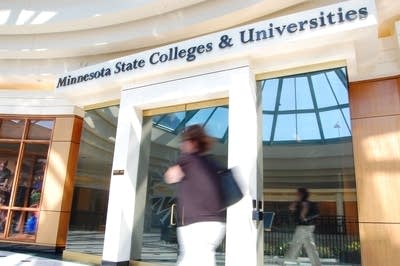Officials split over proposed change in college loans
Go Deeper.
Create an account or log in to save stories.
Like this?
Thanks for liking this story! We have added it to a list of your favorite stories.

There could be big changes ahead in how college students borrow money from the government to pay for tuition.
President Obama wants to take private banks out of the business of handling federally guaranteed student loans. His proposal would end billions of dollars in subsidies to private banks to service those loans, and instead put that money into college funding and grants to students.
Minnesota's college financial aid officials are split over the issue.
Even though the White House proposal has yet to make its way through Congress, some Minnesota schools are already changing how their students get government loans to pay for college.
Turn Up Your Support
MPR News helps you turn down the noise and build shared understanding. Turn up your support for this public resource and keep trusted journalism accessible to all.
This is the first year St. Olaf College in Northfield will do direct lending; meaning the college hands money directly from the Department of Education to the student.
In the past, the college required students to pick a bank to act as sort of a middleman in the deal.
"For students or parents it's a little simpler because they don't have to choose a lender," said Kathy Ruby, St. Olaf's director of financial aid. "They simply go to one place on our Web site and complete a promissory note. There's not much of a decision to make."
"For students or parents it's a little simpler because they don't have to choose a lender."
Ruby said there have been challenges, but so far the change to direct lending has gone well.
"Some small software issues and we haven't actually disbursed money yet," she said. "We're waiting for a patch on a software system to do that, but so far it's been pretty smooth."
Smooth or not, it's a change all colleges in the nation would be forced to go through if Obama's plan is approved by Congress.
The proposal would end the Federal Family Education Loan Program, which pays private lenders subsidies to make and service government guaranteed student loans. The White House said that will save nearly $90 billion in the next 10 years, money that could be spent on the Pell Grant program, community colleges and early childhood education.
The Congressional Budget Office claims the proposal would save less, about $47 billion over the next 10 years. But the U.S. Department of Education is confident the program would save close to $90 billion.
The nation's banks however, aren't in favor of the plan. The Consumer Bankers Association said 35,000 lending industry jobs are at risk if private banks are left out of the system.
John Dean, a lobbyist for the retail banking group, said taking private lenders out that business won't help students.
"We believe if the borrower has a choice there will be an incentive on a part of those servicers," Dean said, "to provide a higher quality of service than would be the case if the Department of Education simply assigns a servicer to a particular borrower with no retail competition to get that business."
Carolyn Zehren has been dealing with direct lending for a decade has heard those concerns, but hasn't actually seen them turn into real problems.
Zehren is the financial aid director at Minnesota State University at Moorhead. She said that when her college began direct lending 10 years ago, students found more flexible repayment plans and lower fees.
Zehren said if there is a problem with service, it's easier to track down in direct lending, rather than working through a system of private lenders.
"It may be a lender issue, or it may be a guarantor issue, or it may be a secondary market issue," Zehren said. "Trying to unravel the source of the issue is much more convoluted in a program that has more players than with direct lending where we have one player."
That one-player system may be easier to navigate, but less than a quarter of the nation's college lending is actually done that way.
In the 2007-2008 school year, private lenders handled 80 percent of student lending, offering 6.5 million students almost $55 billion in student loans.
Moving all of the nation's colleges to direct lending by July of next year seems a bit rushed to Rod Oto, who directs financial aid at Carleton College in Northfield. Carleton currently works with private lenders to offer student loans.
Oto has no doubts that direct lending is working for the colleges that have it in place now.
"But when you add on 4,000 schools in a relatively short period of time, I can't help but think there's going to be problems," Oto said.
Oto said Carleton College won't change its system of lending until it's told to do so by Congress.
The president's proposal is expected to be taken up by the U.S. House in late August and by the U.S. Senate in September.
Dear reader,
Political debates with family or friends can get heated. But what if there was a way to handle them better?
You can learn how to have civil political conversations with our new e-book!
Download our free e-book, Talking Sense: Have Hard Political Conversations, Better, and learn how to talk without the tension.




